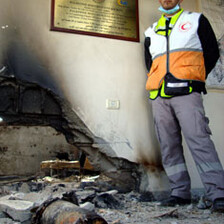East Jerusalem, Palestine 10 April 2002
Tuesday, April 9, a convoy of 14 international representatives and 9 national relief agencies were allowed to enter into Nablus to deliver needed medical supplies and food to the Palestinian Red Crescent Society (PRCS). The supplies will be distributed to those who are in need. The Israeli IDF has occupied Nablus for one week before the convoy entrance into the city. The press was not allowed to enter into the city to film or record the event.
The asphalt has turned into dust along the main entrance road into Nablus. The city is desolate, isolated and a ghost town. Many damaged buildings line the streets and utility poles are toppled over. The only movement outside was that of the Israeli soldiers and tanks buffing up the sand into the air along with periodic cats sitting under an olive tree. Nablus was once a lively city full of shoppers, children with smiling faces and men who were focused on their work. Now, the city is eerie and full of mourning over the deaths of their loved ones who lay rotting in the streets in the Old City area. The Nablutians minds are consumed on survival for the mere needs of bread, medicine, water and cigarettes, a contrast from only over a week ago.
However, no one from the convoy could enter into the Old City area because gun battles, tank shelling and helicopters rang into the day’s air. The amount of killed or injured can only be estimated because it is unknown how many bodies lay under the rumble of the destroyed buildings. The ambulances periodically attempt to enter into the Casaba area (Old City) to deliver medical aid and remove bodies from the streets. The ambulances are shot at an “average of six times” (by the IDF) when they enter into the streets, reported a PRCS medical staff representative. I could see the frustration and concern in their eyes and the desire to get out to assist combined with the risk of getting fired upon while some of the staff was showing me the bullet holes that penetrated the ambulances.
On Tuesday the 9th of April, the same day the convoy entered into Nablus, it is reported that 1000 Old City residents were forced to leave their homes and gather at the Gamal Abdel Nasser school and then the IDF moved them to the Hawara military base. LAW reports that 12 residents were killed. Only a few have been identified, Riziq Baker, 40 and in Askar refugee camp, Hafed Sabra, 60 and Amjad-Abda, 11 were hit by artillery shell. LAW also reports that the IDF entered into the mosque in the Old City and arrested many wounded then closed the field hospital located there.
The famous Soap factory was shelled and the IDF reports that it was a bomb factory. “More than 20 bomb factories have been uncovered there” (Nablus). One IDF solder was killed, Maj. Assaf Asulin, 30 and may have been shot by “friendly fire” according to the IDF.
On April 10th, Army Radio conducted an interview with Deputy Defense Minister Dalia Rabin Pelossof and Deputy Coordinator of Government activities in the Territories and Brig. Gen. Kamil Abu Rokum, “We asked local elements, the Red Crescent, and the Red Cross to handle this matter, and we gave them all the opportunities and all the conditions for doing so. They refused with obvious intentions that were not humanitarian considerations but based on propaganda.” They accused the Palestinians of barring ambulances from the fighting areas. “From the examination that I conducted and the information I received, it is the Palestinians who are not allowing the evacuation of the bodies.” Rabin-Pelossof told the Radio, “They did not want the Red Cross to evacuate the bodies so we suggested doing it ourselves. So far, our suggestions have not been accepted.” (Jerusalem Post)
While arrests and gunfire was occurring in the Old City, I walked the streets just above the gunfire and shelling. It was utter devastation that surrounded me, destruction from tanks and gunfire. Dust and debris was my companion and because of foreign presence, some of the residents ventured outside for the first time in 8 days. They veered smiles and welcome hospitability offering tea and coffee, even when they did not have much for themselves. Hilwah street was lined with 29 crushed automobiles and a destroyed sewer pipe. The automobiles were parked on the sidewalks, “We knew that the IDF was coming so we moved our cars to give room for the tanks”, Ahmed, a resident of the neighborhood stated. He nudges his shoulders, shakes his head with questioning and replies, “It didn’t work.” I could see that standing among the destitute and mingled area.
The Israeli Operation continues and I am loosing my contacts inside Nablus because the telephone lines have been cut and the cell phones are dying due to electricity shut downs. Meanwhile, delivery of medical supplies and food was a success and hopefully it will supply the needs for a few residents until another humanitarian convoy can enter or until the occupation is over.


